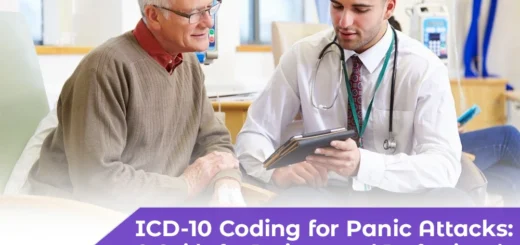
Timely and accurate coding in healthcare goes beyond being an obligatory technical provision; it represents the foundation upon which successful therapy, insurance remuneration, and patient protection rest. It is even more crucial in the area of mental health since a majority of disease symptoms are difficult to categorize and intersect. Panic disorder is one good example of an often miscomprehended ailment that takes ICD-10 code F41.0.
This guide outlines to patients and clinicians the importance of accurate coding for panic attacks, particularly with regard to mental health and anxiety related disorders.
Why Accurate Mental Health Coding is Important
Proper diagnostic coding is not merely medical records; it makes sure an individual gets proper therapy, follow-up treatment, and proper insurance reimbursement. In psychiatry, where diagnoses can overlap and are subjective, errors in coding can have serious consequences, including:
- Misdiagnosis of the disease underlying
- Incorrect prescriptions of drugs.
- Denial of access to therapy or psychiatric treatment.
- Denial of insurance claims or pre-approvals
For health practitioners, proper coding, like F41.0 for panic disorder, helps monitor trends in public health, budget for resources, and carry out credible research on the prevalence of mental health. For patients, it makes their condition seen and taken seriously.
Common Misdiagnosis in Anxiety-Related Disorders
One of the challenges in mental health care is to distinguish among the many anxiety-related disorders. They tend to share similar symptoms, including:
- A racing heartbeat
- Shortness of breath.
- Dizziness
- Excessive worry
- Fear of Losing Control
These symptoms may mimic other illnesses, such as:
- Generalized Anxiety Disorder (GAD).
- Post-traumatic Stress Disorder (PTSD)
- Social Anxiety Disorder
- Heart issues (especially in ER visits)
- Thyroid disturbances
Lacking proper psychiatric assessment, individuals with panic disorder are often misclassified as having GAD (coded as F41.1) or other non-psychiatric illnesses. Such errors result in treatments that ignore the distinctive character of panic attacks—short, intense episodes of fear and bodily distress that seem to come from nowhere.
Knowledge and use of the correct ICD-10 code—F41.0—separate panic disorder from other anxiety disorders, permitting more effective treatment.
How ICD-10 Classifies Panic Disorders and Generalized Anxiety
The ICD-10 (International Classification of Diseases, 10th Revision) offers a structured system of classifying all medical illnesses, including mental illnesses.
This is how panic disorder is different from generalized anxiety disorder.
- F41.0 – Panic Disorder (with or without Agoraphobia) involves repeated, unexpected panic attacks, ongoing fear of future attacks, and behavioral changes to escape them.
- F41.1: People with Generalized Anxiety Disorder (GAD) worry and fear frequently about a lot of different things for six months.
Although both are diseases of anxiety, the episodic nature of panic attacks, along with the fear of subsequent attacks, makes F41.0 different.
These differences have to be grasped not only to treat the patient appropriately but also to record the diagnosis correctly for continuity of future care.
Understanding The Clinical Criteria Behind F41.0
The ICD-10 and DSM-5 both classify Panic Disorder by describing the following features, which are indicated by the F41.0 diagnostic code:
Recurrent and unexpected panic attacks.
One or more attacks were followed by one month (or more) of:
Persistent fear regarding further assaults.
Sustained maladaptive behavioral modification associated with the assaults (e.g., avoiding circumstances or locations)
Panic attacks often peak within 10 minutes and might include symptoms such as:
- Palpitations
- Sweating
- Trembling
- Shortness of breath
- Choking sensations
- Chest pain
- Nausea or abdominal distress
- Fear of dying or losing control
These sudden and acute symptoms often lead individuals to seek emergency medical care, confusing the attack with a heart condition. This provides an extra level of complexity to accurate coding and diagnosis.
Coding F41.0 guarantees that the physiological and psychological aspects of the disorder are treated in the treatment plan.
How This Code Can Impact Treatment Plans
When panic disorder is properly diagnosed as F41.0, it dictates what kind of treatment the patient should get. This can include:
1. Medication
- SSRIs are often prescribed as first-line medications.
- Benzodiazepines can be used for a short time to feel better right away.
2. Psychotherapy
- Cognitive behavioral therapy (CBT) is thought to be the best.
- In case there is agoraphobic behavior, exposure therapy can be used to reduce it.
3. Lifestyle Changes
- Stress Reduction
- Breathing Exercises
- Stimulant avoidance, like coffee.
When a patient is inappropriately diagnosed with GAD or some other anxiety related disorders, they might not get the specific, episodic treatment they need for panic attacks. Proper ICD-10 classification immediately impacts treatment planning, allowing therapies to be tailored to the patient’s condition.
Advice for Patients: Questions to Ask Your Healthcare Provider
If you have experienced panic attacks or have been diagnosed with a disorder related to anxiety, you need to be an advocate for your own health. Get your healthcare professional to answer these questions:
- “Do my symptoms fit Panic Disorder or Generalized Anxiety?”
- “What does my ICD-10 diagnosis code mean, and what does it identify?”
- “Could this code potentially affect my insurance or treatment plan?”
- “Will I benefit from psychotherapy, medication, or both?”
- “Do I require further evaluation by a mental health specialist?”
Being aware of your diagnosis and its classification can enable you to find suitable therapy and minimize the chances of misguided attempts.
Conclusion
ICD-10 coding for panic episodes, especially with F41.0, is more than just a clerical task; it is a critical step in proper diagnosis, effective treatment, and long-term mental health stability. When anxiety illnesses are rightly diagnosed, patients will be treated with medicines best suited to their symptoms, increasing their recovery potential.
For health care providers, correct coding supports research, continuity of patient care, and public health planning. For patients, it translates into a greater understanding of their disease and greater participation in their care process. For more health insights and future updates, stay connected with us here on Enquiry Pharmacy.










